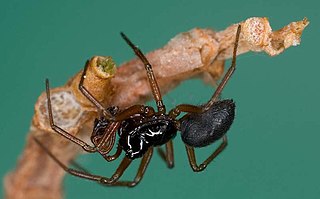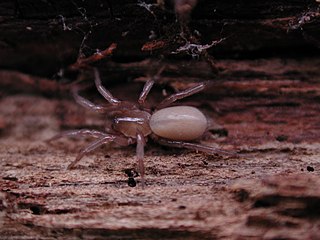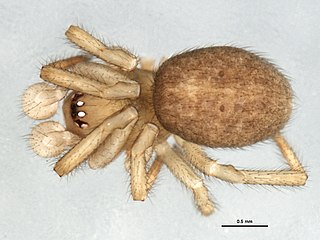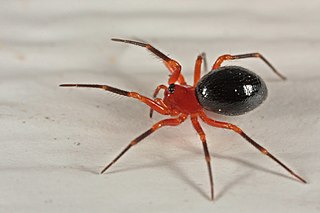
Linyphiidae, spiders commonly known as sheet weavers, or money spiders is a family of very small spiders comprising 4706 described species in 620 genera worldwide. This makes Linyphiidae the second largest family of spiders after the Salticidae. The family is poorly understood due to their small body size and wide distribution; new genera and species are still being discovered throughout the world. The newest such genus is Himalafurca from Nepal, formally described in April 2021 by Tanasevitch. Since it is so difficult to identify such tiny spiders, there are regular changes in taxonomy as species are combined or divided.

Dictynidae is a family of cribellate, hackled band-producing spiders first described by Octavius Pickard-Cambridge in 1871. Most build irregular webs on or near the ground, creating a tangle of silken fibers among several branches or stems of one plant.

Amaurobius is a genus of tangled nest spiders that was first described by Carl Ludwig Koch in 1837.

Enoplognatha is a genus of comb-footed spiders that was first described by P. Pavesi in 1880. They have both a large colulus and a subspherical abdomen. Males usually have enlarged chelicerae. It is considered a senior synonym of Symopagia.

Erigone is a genus of dwarf spiders that was first described by Jean Victoire Audouin in 1826. They are carnivorous, preying on small insects such as Psylla and flies. One of the distinctive characters for this genus is the presence of teeth bordering the carapace.

Cicurina, also called the cave meshweaver, is a genus of dwarf sheet spiders that was first described by Anton Menge in 1871. Originally placed with the funnel weavers, it was moved to the Dictynidae in 1967, then to the Hahniidae in 2017. The name is from the Latin root "cucur-", meaning "to tame".

Dictyna is a genus of cribellate araneomorph spiders in the family Dictynidae, and was first described by Carl Jakob Sundevall in 1833.

Agyneta is a genus of dwarf spiders that was first described by J. E. Hull in 1911.
Scotinotylus is a genus of sheet weavers that was first described by Eugène Louis Simon in 1884.

Ceraticelus is a genus of dwarf spiders that was first described by Eugène Louis Simon in 1884.

Robertus is a genus of comb-footed spiders that was first described by Octavius Pickard-Cambridge in 1879. It is considered a senior synonym of Garritus.

Cybaeopsis is a genus of tangled nest spiders first described by Embrik Strand in 1907, and transferred from Agelenidae to Amaurobiidae by Pekka T. Lehtinen in 1967. They all occur in North America except for three species; C. lodovicii, C. theoblicki and C. typica.

Dismodicus is a genus of dwarf spiders that was first described by Eugène Louis Simon in 1884.

Hypselistes is a genus of dwarf spiders that was first described by Eugène Louis Simon in 1894.














